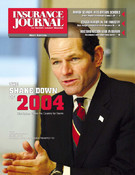Agency consolidations are likely to achieve record results for 2004 but the outlook for 2005 remains unclear. Agency acquisitions in 2004 will more than likely outpace prior years by at least 25 percent. Insurance brokers continue to make a significant impact in consolidation, representing 53 percent of all announced deals as of Sept. 30, and already outpacing their total 2003 results by 10 percent. As product rates continue to soften and stabilize, public company brokers are accelerating their buying pace to close the gap on declining organic revenue gains.
There are several developing factors that may re-shape the consolidation pace during 2005. The direction of product rates, long-term capital gains rates, and the impact that banks have on agency consolidation are all key dynamics that may shift the pace during 2005.
“The recent Eliot Spitzer case against Marsh McClennan may redefine the entire insurance brokerage segment and their appetite for acquisitions in the upcoming year,” suggests Robert Lieblein, a managing principal of WFG Capital Advisors. “This is probably the most salient issue facing the market today and it is too difficult to predict its outcome. New entrants such as private equity groups are beginning to make some significant headway into the market while financial institutions appear to be retrenching. The combination of these two segments will have significant impact on the marketplace in the upcoming year.”
Agency consolidation has increasingly captured the attention of industry professionals in the past 15 months. The key question among most is whether the level of activity will continue during 2005, and beyond. At this point, it is safe to say that the outlook through the first quarter of 2005 is optimistic. Beyond this timeframe, things begin to get cloudy.
Recap of announced transactions
A review of announced agency acquisitions for the nine months ending Sept. 30 clearly supports that 2004 agency transactions are on a record-setting pace. The number of acquisitions announced in 2004 has virtually surpassed the overall total for 2003 and are expected to top 225 (versus 182 in 2003). This represents at least a 30 percent increase over a year when the pace of acquisitions was fairly brisk.
Announced transactions (2000-2004) by major buying segment would strongly suggest that banks have softened their formerly aggressive postures toward insurance platforms. One key contributor to this trend is that many banks have opted to ride out the cycle of softening product rates and wait until they can continue to sustain the necessary lift in commissions from more adequate pricing. Some banks have taken the opportunity to re-trench and focus on integration of prior acquisitions. Most financial institutions have the benefit of “shielding” their insurance operations from shareholders due to their immaterial nature relative to consolidated results. This provides them with the ability to deploy a defensive strategy and to remain patient.
As of Sept. 30, brokers, who already have outpaced their entire 2003 acquisition total, account for 53 percent of all deals and are expected to be the leading segment at least until the product market stabilizes.
A new emerging segment of agency buyers appears to be private equity groups. Many investors view the insurance distribution channel as highly viable, particularly when product rates compress and theoretically drive agency values down. A number of large, well-capitalized groups have begun to infiltrate the market and are expected to become even more dominant should market conditions remain unchanged. Likewise, many insurance carriers have adopted strategies to acquire distribution outlets. In many cases, carriers view the opportunity to either gain greater market share on their proprietary products or capture additional revenues by offering non-proprietary options to their clients.
Career brokerage struggles
Meanwhile, career brokerage operations do not have the fortune of being as patient as others and must continue to aggressively pursue acquisition opportunities. The softening market has left most middle market career brokers seeking to cover their lost organic growth with that which is acquired. Any immediate change in product rate firming seems highly unlikely for the next three to six months, which puts increased pressure on brokers to continue with deployment of acquisition strategies to bolster growth. If there is no indication that product rates will stabilize after Jan. 1, and the impending actions of Spitzer do not wreak havoc on the brokerage segment’s market capitalization, it is reasonable to expect leading acquirers, such as Brown and Brown, Hub International, Arthur Gallagher and USI will continue with their rapid-paced acquisitions.
As we round the corner into 2005, several key factors will continue to determine the pace in which consolidation occurs:
Product rates
Commercial product rates will have a resounding impact on mergers and acquisitions and will crystallize as 2005 reinsurance capacity is better quantified. There is speculation that the recent domestic rash of catastrophic losses will create a “correction cycle” early in 2005. Likewise, there is some contention that there is plenty of capacity to weather the storms and that there is no near term end to the rate decreases, especially among commercial property. Much will be determined in the early phases of 2005 as primary carriers will secure new catastrophe covers as well as re-negotiate their primary treaties. This will ultimately manifest itself in product rates during the course of the year. If there is moderate price firming, expect banks to re-emerge as a major consolidator. If there is little or no change, then expect the career brokerage segment to continue leading among acquirers.
Benefits market
The benefits market continues to play a critical role in acquisitions. This is clearly one segment of the market that, for the most part, has sustained strong organic growth among brokers who offer commissionable products. As health care costs continue to increase, brokers who offer off-the-shelf solutions are realizing growth and attracting increased attention from all segments of the acquiring community. It is likely that benefit operations will continue to emerge as a more significant component of the targeted businesses, particularly if commercial product rates do not change.
Long-term capital gains tax
The long-term capital gains rate has been a key component behind many agency owners’ motivation to explore being acquired. The reduction in the tax rate in 2003 captured the interest of many agency owners who were in the midst of exploring, or considering succession planning strategies. In essence, this tax reduction amounted to 25 percent less tax paid on purchase prices treated as capital gains. This has prompted many agency owners to explore opportunities and to accelerate their long term planning strategies as the window on this opportunity may be drawn to a close. Many large acquiring firms have stated that their acquisition pipelines are full, which further supports the mad dash to capitalize on this opportunity.
Capital markets
Capital markets play a key role in acquisition activity, especially among career brokers. As shareholder confidence wanes, market capitalization shrinks and public companies lose their ability to continue to deploy their acquisition strategies, or, at the very least, slow their initiatives. Two key developments that can shape the loss of capitalization are (1) continued loss of organic growth; and (2) Spitzer’s case against Marsh. The brokerage segment has suffered tremendous declines in market capitalization as a result of both matters. The Spitzer case has far reaching implications to the entire insurance brokerage industry and is expected to go far beyond Marsh. If shareholder confidence and capitalization declines persist, public buyers will struggle to rationalize growth by acquisition until both matters are resolved and the market gets back on a steady course. These two events, individually, or collectively, have the ability to force many of the leading acquirers to re-trench, ride out the market cycle, and wait for further developments in the Spitzer case.
Conclusion
As we head into 2005, variables that drive agency consolidation present quite a contrast that can take the market in either direction. One item that remains quite clear is that the prospect of a mega merger is not beyond the realm of possibility. Marsh and Aon have publicly committed to focusing efforts on middle market penetration during the past year and may be on the hunt for a large, publicly-traded, middle market broker to consume.
Conversely, it is not unlikely that a major financial institution may pursue an industry leading broker as an acquisition target. In either event, these cloudy issues will become clearer when the industry absorbs and measures the impact of the Spitzer case. Acquisition activity during the next year should present some very interesting, and surprising results.
Steven S. Wevodau and Robert Lieblein are managing principals of WFG Capital Advisors, a Harrisburg, Pa., investment banking firm specializing in the insurance industry. Wevodau and Lieblein were presenters at the recent
ASCnet Conference in Orlando.
Was this article valuable?
Here are more articles you may enjoy.


 Lawsuit Alleges Farm Bureau Financial Concealed Fraudulent Activities
Lawsuit Alleges Farm Bureau Financial Concealed Fraudulent Activities  Businessman, Former Federal Insurance Co. Attorney Hit With $50M Florida Verdict
Businessman, Former Federal Insurance Co. Attorney Hit With $50M Florida Verdict  Florida, East Coast to See Big Insured Losses From More Cat 5 Storms, Researchers Say
Florida, East Coast to See Big Insured Losses From More Cat 5 Storms, Researchers Say  Litigation Finance Hits a Wall After Bets on Huge Gains Falter
Litigation Finance Hits a Wall After Bets on Huge Gains Falter 


